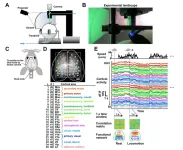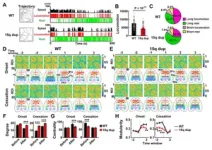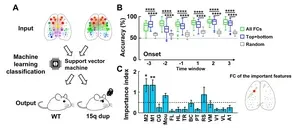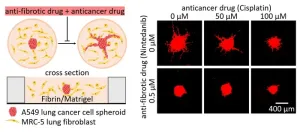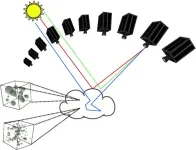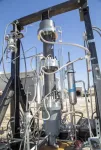(Press-News.org) An international research collaboration has developed a VR*1 imaging system that can measure a wide range of neural activity in the cortices of mice during active behavior. This enabled them to illuminate the abnormalities in cortical functional network*2 dynamics that are found in autism*3 model mice. Using machine learning*4, they were also able to highly accurately distinguish between autism model mice and wild-type mice based on the cortical functional network patterns when the mice start or stop running. The research group was led by Professor Toru Takumi and Assistant Professor Nobuhiro Nakai (both of the Department of Physiology, Kobe University Graduate School of Medicine), and Masaaki Sato, (Lecturer, Department of Pharmacology, Graduate School of Medicine, Hokkaido University). Professor Takumi is also a Visiting Senior Scientist at RIKEN Center for Biosystems Dynamics Research.
Future research on functional brain network dynamics in autism is expected to lead to the development of new biomarkers for autism diagnosis.
The results of this research will be published in Cell Reports on March 28 at 11am (ET).
Main Points
The researchers developed a VR imaging system that can measure a wide range of cortical activity from mice in action.
Mice models of autism have dense cortical functional networks and reduced modularity*5 after motor initiation.
Machine learning can highly accurately identify autism model mice from their cortical functional network patterns.
Research Background
Autism (autism spectrum disorder) is a neurodevelopmental disorder with many unexplored aspects, characterized by poor social communication, intense preoccupation with certain things, and repetitive behaviors. The number of autistic individuals is markedly increasing, which is considered to be a significant social issue. Even now, autism diagnosis is based on behavioral characteristics, which is far from a quantitative perspective, and there is great demand for the discovery of a new biomarker.
In recent years, research has been conducted to identify functional brain abnormalities unique to autistic individuals. Resting-state fMRI*6 studies suggest that the density of functional brain networks increases in young autistic individuals and decreases in adults (Ref. 1). However, these changes vary widely from individual to individual. As the analysis was conducted when the participants were in a resting state, it was unclear how abnormalities in functional brain networks affect behavior.
Genetics contribute significantly to autism, and genomic abnormalities such as copy number variations (CNV) *7 are thought to be involved in neuropathology. Recently, animals (mainly mice) modeling human genomic aberrations are often used to elucidate the neuropathology of autism. In this study, the researchers developed a VR imaging system that can measure the brain activity of autism model mice in real-time during active behavior. By investigating brain functional network dynamics, the research group aimed to clarify autism-specific phenomena in the brain during behavior.
Results
First, a VR imaging system was constructed (Fig. 1A). A mouse with its head fixed in place is put on a treadmill and shown an image of a virtual space projected on a screen. The virtual space was prepared so that it reproduced the field used for mouse behavioral experiments. The motion of the treadmill is reflected in the video images, allowing the mice to freely explore the virtual space (Fig. 1B). Alongside behavioral measurements such as locomotion, transcranial calcium imaging*8 was performed simultaneously so that a wide range of functional area activity in the cerebral cortex could be measured in real time (Fig. 1C-E). For this purpose, the researchers used transgenic mice that express calcium sensor protein (GCaMP)*9 in their neurons. In addition, they established a method for analyzing cortical functional network dynamics. They calculated correlations between functional areas from one-second neural activity data obtained via calcium imaging, and visualized the functional network using graph theory (Fig. 1E).
The researchers analyzed the 3 second time windows before and after when the mouse spontaneously started or stopped moving on the treadmill (locomotion) and examined the network characteristics in each time window. The results revealed that the network structure changes with the onset of locomotion and that modularity increases (Fig. 2). It was also found that the network structure returns to the resting state when locomotion is stopped. Thus, they succeeded in visualizing the network dynamics during the switch from rest to locomotion and from locomotion to rest.
Next, the researchers used this VR imaging system to analyze the functional cortical network of autism model mice. For the experiment, they used 15q dup mice*10, the first established mouse model of autism with copy number variations. 15q dup mice exhibited reduced locomotion and distance traveled in VR space (Fig. 2A-C). Examination of the functional cortical network revealed higher network connections after locomotion initiation, decreased network centrality, and decreased modularity of the functional network (Fig. 2D-I).
Based on these differences in network patterns, the researchers attempted to identify autism model mice by cortical function networks using support vector machines (SVM), a type of machine learning (Fig. 3A). The network patterns of multiple individual 15q dup mice and wild-type mice were used as a training data and the SVM was able to distinguish whether individual test data was from an autism model mouse or not with 78~89% accuracy rate (Fig. 3B). This result suggests that the functional brain network during behavior contains versatile information about the genotype identification. The researchers also examined which information was influential in the brain and found that functional connectivity in the motor cortex was essential for identification in autism model mice (Fig. 3C).
In summary, the 15q dup mice, a model of autism, had a dense functional cortical network during locomotion and reduced modularity. The researchers also found that machine learning can identify autism model mice in a highly accurate manner based on their functional cortical network patterns that are associated with behavioral changes.
Further Research
The functional brain network in mouse models of autism is characterized by the functional connectivity of the motor cortex, which is crucial for determining autism. Detailed studies of these anatomical connections and neurophysiology will help elucidate which networks between the motor cortex and other brain regions play critical roles in autism pathology. In addition, further research on the functional brain network dynamics of autism during active behavior is expected to lead to the discovery of new biomarkers for the diagnosis of autism.
By analyzing the extensive cortical activity recorded from active mice, the researchers were able to visualize the dynamic behavior-dependent changes in the functional cortical network of the brain. VR allows for the creation of multimodal environments that utilize multiple sensory information, including visual, auditory, and olfactory senses. Since a significant symptom of autism in people is impaired social communication, the researchers would like to construct a social environment for mice in the virtual space and investigate how the functional network dynamics change when autism model mice perform social behaviors.
Glossary
※1 VR (Virtual Reality):
A 3D space created by a computer. In VR for humans, images are viewed through a headset, etc. In VR for mice, a virtual space is projected onto a dome-shaped screen to provide an immersive experience. Mice can freely explore the virtual space by walking on a treadmill.
※2 Autism (Autism Spectrum Disorders):
Autism is a neurodevelopmental disorder whose main behavioral characteristics include impaired social communication and interaction, and repetitive behaviors. Although various types of genetic mutations and genomic abnormalities have been reported in autistic individuals, the cause in many autism cases remains unknown.
※3 Functional Network:
A network represented by a functional linkage derived from time-series changes in activity between two regions. When two regions show strongly synchronized (highly correlated) activity with each other, the functional coupling is strong. Graph theory is one of the methods to visualize functional brain networks. The network structure can be shown by graphing nodes (brain regions) and edges (functional connections) that cross the correlation threshold.
※4 Machine Learning:
A technology in which a machine (computer) learns from a large amount of data (training data) to find rules and patterns in the background of the data to predict and classify unknown data (test data). It is classified into supervised learning, unsupervised learning, and reinforcement learning. The support vector machine used in this study is trained through supervised learning, which is used for many classification problems such as speech and image recognition.
※5 Modularity:
Modules are groups (clusters) that form part of a network. They are categorized by similarity and connectivity. Modularity refers to how many modules a node (brain region) in a network can be divided into.
※6 fMRI (functional magnetic resonance imaging):
A method to measure regional cerebral blood flow changes associated with neural activity. Although the temporal resolution is low, it can comprehensively measure the activity of the entire brain.
※7 Copy number variation:
A deletion or duplication of genomic DNA spanning more than 1 kb on a chromosome. Can be a genetic cause of a disease if it contains a gene implicated in the disease.
※8 Transcranial Calcium Imaging:
Calcium imaging is a technique to optically measure neural activity-dependent calcium concentration changes in cells and tissues. It has a higher temporal resolution than fMRI because measurements can be made in tens of milliseconds. It is also less invasive for the brain because it measures neural activity through the skull (transcranial), eliminating the need to remove the skull.
※9 Calcium sensor protein (GCaMP):
A protein used to detect intracellular calcium ion concentrations via fluorescence signals, GCaMP is a genetically engineered protein probe that combines green fluorescent protein, calmodulin, and a myosin light chain fragment. The binding of calcium ions increases the fluorescence intensity of GCaMP. Since the intracellular calcium concentration increases when neurons are active, neural activity can be also detected as a change in GCaMP fluorescence intensity.
※10 15q dup mice:
A mouse model that recapitulates the human chromosome 15q11-13 duplication found at high frequency in patients with autism. 15q dup mice exhibit impaired social behavior. Previous studies have identified abnormalities in cortical synaptic connections and the serotonergic nervous system, as well as reduced functional connectivity throughout the brain at rest, but have not examined how brain function is altered when mice exhibit active behavior. In this study, the researchers cross-bred GCaMP transgenic mice and 15q dup mice so that they could use a VR imaging system to analyze brain activity of autism model mice during active behavior.
Acknowledgements
This research was supported by a Grant-in-Aid for Scientific Research (S) from the Japan Society for the Promotion of Science (JSPS), the Japan Science and Technology Agency Moon Shot Type Research and Development Project, Goal 9, and the Takeda Science Foundation Research Grant.
Journal Information
Title:
“Virtual reality-based real-time imaging reveals abnormal cortical dynamics during behavioral transitions in a mouse model of autism”
DOI: 10.1016/j.celrep.2023.112258
Authors:
Nobuhiro Nakai1,2, Masaaki Sato1,3*, Okito Yamashita4,5, Yukiko Sekine1, Xiaochen Fu1, Junichi Nakai6, Andrew Zalesky7, Toru Takumi1,2,8,9*
1 RIKEN Brain Science Institute, Wako, Saitama 351-0198, Japan
2 Department of Physiology and Cell Biology, Kobe University School of Medicine, Kobe 650-0017, Japan
3 Department of Neuropharmacology, Hokkaido University Graduate School of Medicine, Kita, Sapporo 060-8638, Japan
4 RIKEN Center for Advanced Intelligence Project, Chuo, Tokyo 103-0027, Japan
5 Department of Computational Brain Imaging, ATR Neural Information Analysis Laboratories, Seika, Kyoto 619-0288, Japan
6 Division of Oral Physiology, Department of Disease Management Dentistry, Tohoku University Graduate School of Dentistry, Aoba, Sendai 980-8575, Japan
7 Melbourne Neuropsychiatry Centre and Department of Biomedical Engineering, The University of Melbourne, Victoria, 3010, Australia.
8 RIKEN Center for Biosystems Dynamics Research, Chuo, Kobe 650-0047, Japan
9 Lead contact
*Corresponding authors
Journal:
Cell Reports
END
Using virtual reality to investigate autism’s neural network dynamics
-Too much communication in the Autistic Brain-
2023-03-28
ELSE PRESS RELEASES FROM THIS DATE:
Fibroblast inhibitors assist anti-cancer drugs to suppress cancer growth
2023-03-28
WASHINGTON, March 28, 2023 – Fibroblasts build and maintain the extracellular matrix, or physical scaffolding for cells, in the connective tissues within the body. It is believed that cancerous tumors can recruit nearby fibroblasts and use them to promote their own growth and invasion. This process, called cancer-associated fibroblast activation, can also protect tumors from chemotherapy and make treatment difficult.
In APL Bioengineering, by AIP Publishing, researchers from Academia Sinica, National Yang Ming Chiao Tung University, National Taiwan University Hospital, and National Taiwan University developed ...
Risk of adverse surgical outcomes among patients with recent COVID-19 infection
2023-03-28
About The Study: The findings of this study that included 29,000 patients suggest that recent COVID-19 infection was not associated with risk of adverse postoperative outcomes, regardless of timing within the previous 60 days.
Authors: William J. O’Brien, M.S., of Veterans Affairs Boston, is the corresponding author.
To access the embargoed study: Visit our For The Media website at this link https://media.jamanetwork.com/
(doi:10.1001/jamanetworkopen.2023.4876)
Editor’s Note: Please see the article for additional information, including other authors, ...
Association of daily step patterns with mortality in adults
2023-03-28
About The Study: In this study of 3,101 adult participants, the number of days per week taking 8,000 steps or more was associated with a lower risk of all-cause and cardiovascular mortality in a curvilinear fashion. The findings suggest that for adults who face difficulties in exercising regularly, achieving the recommended daily steps only a couple days a week may have meaningful health benefits.
Authors: Kosuke Inoue, M.D., Ph.D., of Kyoto University in Kyoto, Japan, is the corresponding ...
PCORI approves $123 million for research on postpartum care, hypertension management, antibiotic prescribing and a range of conditions
2023-03-28
WASHINGTON, DC – The Patient-Centered Outcomes Research Institute (PCORI) today announced funding awards totaling $123 million to support 15 new research studies. These studies aim to fill evidence gaps, enhance research methods, or improve health care decision making for a range of high-burden concerns among adults and children, including postpartum complications occurring in populations experiencing the greatest disparities in health outcomes.
In addition, PCORI awarded $4 million for two implementation projects intended to accelerate uptake of strategies shown in PCORI-funded studies, one to improve decision making about colorectal ...
Molecular mechanisms of disease pathophysiology: Journal of Pharmaceutical Analysis articles provide novel insights
2023-03-28
The burden of cardiovascular, metabolic, and neurological diseases (including ischemic heart disease, stroke, diabetes, and Parkinson’s disease) is particularly high, and these conditions affect millions around the world annually. In order to develop effective treatment strategies against these diseases, it is important to delineate the cellular and molecular pathways that contribute to their development. Three pre-clinical studies published in Volume 13 Issue 2 of Journal of Pharmaceutical Analysis have done just that.
The first study, published online on December 5, 2022, focused on myocardial infarction (MI), better known as a heart attack. Given that the ...
New study reveals clinical instability predicts psychiatric hospitalization
2023-03-28
NEW YORK — MARCH 28, 2023 – For patients with psychiatric conditions, illness severity and instability are key factors in predicting future risk of hospitalization, according to a new study by Holmusk, a leading behavioral health real-world evidence and data analytics company, that has been published in The Lancet Psychiatry. The study, which was enabled by Holmusk’s NeuroBlu Database, could prove useful across the behavioral health care and research ecosystem, from facilitating early intervention to supporting the development of more targeted treatments.
The research was conducted using Holmusk’s NeuroBlu Database, a real-world data source that contains ...
New method for fast, efficient and scalable cloud tomography
2023-03-28
How do clouds shape the planet’s future? Clouds are not just fluffy white shapes in the sky. They are vital for regulating the earth’s climate, as they influence the water cycle, atmospheric dynamics and energy balance. However, studying clouds is not easy. One way to do so is to use spaceborne imagers, but these imagers still face challenges of efficiency and scalability. To overcome these limitations, Ido Czerninski and Yoav Y. Schechner from the Viterbi Faculty of Electrical and Computer Engineering at the Technion—Israel Institute of Technology, a partner of CloudCT, have developed an effective inverse rendering framework ...
How to protect the integrity of survey research: 12 recommendations
2023-03-28
Science requires data, and survey research is one important means of gathering it. Surveys provide a scientific way of acquiring information that is used to inform policy decisions, guide political campaigns, clarify the needs of stakeholders, enhance customer service, help society understand itself, and improve the quality of life in the United States.
In recent years, concerns have been raised about growing rates of refusal to participate in surveys, as well as about inaccurate forecasts in high-profile ...
Significant disparities in breast cancer care persist, but surgeons can drive change
2023-03-28
Key takeaways
Inequitable access to breast cancer care: Treatment options for breast cancer are increasing, but many groups still do not have equitable access to preventative services, such as screening mammograms, and new therapies or drugs.
Wide spectrum of disparities: Screening, genetic testing, reconstruction, and fertility preservation are four significant areas where disparities exist and where surgeons should maintain awareness.
Surgeons can drive change: Surgeons can raise the standard of care at their institutions by improving their understanding of these disparities and advocating for their patients.
CHICAGO: Surgeons can play a key role ...
SwRI creates innovative, efficient hydrogen compressor for FCEV refueling stations
2023-03-28
SAN ANTONIO — March 28, 2023 - A new hydrogen compressor developed at Southwest Research Institute (SwRI) can improve the efficiency and reliability of hydrogen compression used in the refueling of fuel cell electric vehicles (FCEVs). The SwRI-developed linear motor-driven reciprocating compressor (LMRC) is designed to compress hydrogen as a fuel source for FCEVs and other hydrogen-powered vehicles. Unlike most hydrogen compressors, SwRI’s LMRC is hermetically sealed and has a linear motor design that increases its ...
LAST 30 PRESS RELEASES:
Air pollution exposure and birth weight
Obstructive sleep apnea risk and mental health conditions among older adults
How talking slows eye movements behind the wheel
The Ceramic Society of Japan’s Oxoate Ceramics Research Association launches new international book project
Heart-brain connection: international study reveals the role of the vagus nerve in keeping the heart young
Researchers identify Rb1 as a predictive biomarker for a new therapeutic strategy in some breast cancers
Survey reveals ethical gaps slowing AI adoption in pediatric surgery
Stimulant ADHD medications work differently than thought
AI overestimates how smart people are, according to HSE economists
HSE researchers create genome-wide map of quadruplexes
Scientists boost cell "powerhouses" to burn more calories
Automatic label checking: The missing step in making reliable medical AI
Low daily alcohol intake linked to 50% heightened mouth cancer risk in India
American Meteorological Society announces Rick Spinrad as 2026 President-Elect
Biomass-based carbon capture spotlighted in newly released global climate webinar recording
Illuminating invisible nano pollutants: advanced bioimaging tracks the full journey of emerging nanoscale contaminants in living systems
How does age affect recovery from spinal cord injury?
Novel AI tool offers prognosis for patients with head and neck cancer
Fathers’ microplastic exposure tied to their children’s metabolic problems
Research validates laboratory model for studying high-grade serous ovarian cancer
SIR 2026 delivers transformative breakthroughs in minimally invasive medicine to improve patient care
Stem Cell Reports most downloaded papers of 2025 highlight the breadth and impact of stem cell research
Oxford-led study estimates NHS spends around 3% of its primary and secondary care budget on the health impacts of heat and cold in England
A researcher’s long quest leads to a smart composite breakthrough
Urban wild bees act as “microbial sensors” of city health.
New study finds where you live affects recovery after a hip fracture
Forecasting the impact of fully automated vehicle adoption on US road traffic injuries
Alcohol-related hospitalizations from 2016 to 2022
Semaglutide and hospitalizations in patients with obesity and established cardiovascular disease
Researchers ‘listen in’ to embryo-mother interactions during implantation using a culture system replicating the womb lining
[Press-News.org] Using virtual reality to investigate autism’s neural network dynamics-Too much communication in the Autistic Brain-
